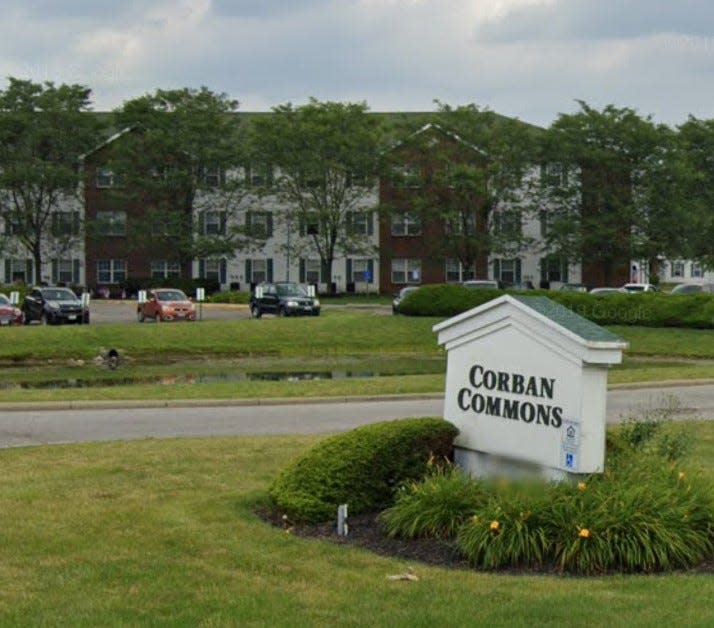Columbus, Franklin County provide total $9 million to jump-start nonprofit solar projects

A green-energy fund created with a total $9 million from Columbus and Franklin County taxpayers announced its first investment to jump-start small solar energy projects Tuesday: a 500-kilowatt panel installation at a nonprofit senior apartment complex on the city's Northeast Side.
In December 2022, Columbus City Council approved a $7-million contribution to the Columbus Region Green Fund, managed by the Columbus Partnership, the organization that represents the largest companies in the Columbus area. The program has since secured another $2 million from Franklin County.
The new program presented Corban Commons — a 23-year-old retirement community on Agler Road near Stelzer Road south of Easton Town Center — a money-saving and environmentally friendly deal it couldn't refuse, said Johnny Pitts, president of Dayspring Christian Community Development Corp., one of three nonprofit CDCs that founded the 91-unit facility for low- and moderate-income seniors.
Backers of the green fund, including Columbus Mayor Andrew J. Ginther, held a ceremony Tuesday afternoon at the complex to mark the milestone agreement, in which Corban Commons will pay nothing up front for the major solar installation. It will then lock into a long-term power purchase agreement with the installation firm for just under 5 cents per kilowatt-hour, or about a third less than it currently pays for electricity.
After two decades of making the payments, which include 1.6% annual inflation adjustments, the complex will own the solar panels outright, with about 15 more years left on their estimated life cycle. The total estimated energy savings over 35 years: more than $2 million.
"We have to try to control overall costs of managing this property and keeping the rents affordable," Pitts said. "If we can lower the energy costs, and take that savings, then it lowers our debt service" and increases cash flow, allowing for further reinvestment in the future."
The solar panels will be installed as part of a $12 million total renovation of the facility and an adjacent facility also managed by Pitts, he said. The environmental impact, he contends, is the equivalent of planting more than 17,000 acres of forest because the solar panels essentially eliminate almost 16,000 tons of carbon dioxide.
Corban Commons is just the first of an estimated 75 nonprofit facilities in Franklin County that could get the same terms from the new program, said Zach McGuire, who runs the green fund for the Columbus Partnership. The fund is like a bank, covering start-up costs to boost the confidence of banks and solar installation firms that they'll get repaid, reducing their risk, McGuire said.
"There's no up-front capital investment from the organization" that receives the panels, McGuire said. Their only cost is for electricity.
McGuire said in his opening remarks that the funds would be used not only for nonprofits but to help create affordable housing and aid low-to-moderate-income small businesses.
After the $9 million in seed money from the city and county is depleted, the Columbus Partnership hopes to get a piece of $27 billion in new federal grants targeted for such programs to keep the effort growing, McGuire said.
"It's an initial investment that will allow us to grow, bring down more dollars from the feds, ensure that we can keep doing the work and saving people money in the community for decades to come," McGuire said.
That may someday include programs helping single-family homeowners install solar panels, he said.
How will the Columbus Partnership decide who will get the assistance?
McGuire said an appointed board oversees the program, and will consider things like how much will installation of solar reduce rents or utility costs.
What's in it for the public to pay these costs?
Kevin Boyce, president of the Franklin County Board of Commissioners, said at the event that one future benefit is a more reliable electric grid. If in the future more power is locally generated, that will take the stress off a sometimes overloaded distribution system and help keep the lights on for everybody, he said.
While the program will provide small solar installations, larger-scale solar projects have been slow out of the gate for the city. The Dispatch reported in May that the city's green energy aggregation program — which all former city AEP customers in mid-2021 automatically were enrolled in unless they opted out — was supposed to be well into installing major solar installations across the state for Columbus residents, but the plan stalled under permitting problems.
The city then announced in May that its municipal utility would install 45 megawatts of solar capacity at two municipally owned sites on the South Side. But it's unclear how good or bad of a deal those facilities represent for Columbus residents, as the cost the city agreed to pay is a trade secret of Florida-based NextEra Energy, and not even the City Council is allowed to review the terms.
wbush@gannett.com
@ReporterBush
This article originally appeared on The Columbus Dispatch: Columbus Partnership to invest $9M seed cash in small solar projects
